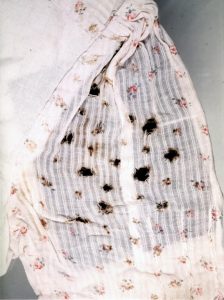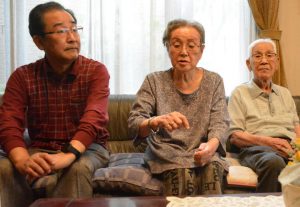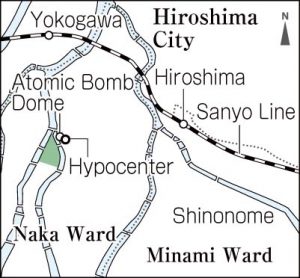Striving to fill voids in Hiroshima, evidence of victims remains—Photos taken by U.S., Part 3: Blouse with floral pattern
Nov. 2, 2022
Stark reminder of painful burns
by Kyosuke Mizukawa, Senior Staff Writer
In the fall of 1945, the United States Strategic Bombing Survey team entered Hiroshima City to study the effects from the atomic bombing. Among their interests were clothes exposed to the A-bombing’s thermal rays, which they recorded in photographs. They took four photos, including one rare color photo of a white short-sleeve blouse with a red rose pattern that had been burned in the bombing. One photo shows a tag reading “SHIBATA” that had been attached to the blouse in an attempt to organize the materials.
“I knew it was mine as soon as I saw it.” Shizue Yamamoto (née Shibata), 98, a resident of the town of Oiso in Kanagawa Prefecture, got goose bumps when she discovered the photo at an A-bombing exhibit held in the prefecture in 1981. Recalling the painful experience of the bombing, she said looking back at that time, “For a moment I felt as if I had been doused with cold water.”
Shizue was born in Los Angeles in 1924. Her grandfather had immigrated to the United States from Hiroshima, and her mother was managing an inn in Los Angeles when Shizue was born. With her mother busy at work, her grandfather returned to Japan with Shizue, who was around two years old, and raised her in the area of Shinonome-cho (now part of Hiroshima’s Minami Ward), where relatives were living.
On the morning of August 6, 1945, 21-year-old Shizue left for work at a munitions factory, located near the Yokogawa train station (in Hiroshima’s Nishi Ward), wearing the blouse. Studying dressmaking, she had sewn it herself with cloth her mother had sent to her from the United States. As she walked in front of Hiroshima Station (in the city’s present-day Minami Ward), the atomic bomb detonated.
“Suddenly, I became shrouded in light. At first, I thought there had been an electrical short circuit.” She was exposed to the A-bombing’s thermal rays and blast from her left side at a distance of about 1.8 kilometers from the hypocenter. Her body grew hot, but she had no idea why. When she fled to a nearby air-raid shelter, there were many people whose skin was peeling from burns.
Although she managed to return home, her left arm and leg were severely burned. To put her at ease, oil was applied to her wounds. “When I was lying on tatami mats on the floor, it even hurt when people simply walked by.” She also lost her hair. It took about three months before her wounds and the other symptoms finally subsided.
Red color absorbed heat
She was requested to hand over the clothes she had on at the time of the bombing but does not remember anything about what happened to them. There is a record of the blouse with a color photo in the publication Encounter With Disaster: A Medical Diary of Hiroshima, 1945 (published in 1965), which was written by Averill Liebow, a lieutenant colonel in the United States Army Medical Corps at the time who had joined the survey team in Hiroshima.
According to the publication, Dr. Liebow and other military personnel took the photo on November 10, 1945, considering it a “particularly noteworthy” item. The blouse’s pattern of crimson rose petals absorbed more heat than the green leaf pattern had. The military had worked to analyze differences in absorption of thermal rays according to color.
In addition to her exposed forearm, there was an area beneath the floral pattern on her upper arm that was burned more severely despite it being covered by the blouse sleeve. She was unable to freely bend her left arm due to burn scars that ultimately became keloids, necessitating numerous skin-graft surgeries.
For about 15 years after the war, she suffered repeated bouts of illness. Nevertheless, she raised three children with the support of her now 98-year-old husband, Satoshi, whom she knew before the war and married in 1946. The couple moved to Kanagawa Prefecture to help her mother who, after her time in the United States, had begun a trade business in the prefecture after the war.
A-bombing experience compiled into booklet
Shizue did not share details of her A-bombing experience with her family. However, her second son, Tatsumi, 70, who lives with her now, saw the photo of the blouse by chance at the Peace Memorial Museum when he was visiting Hiroshima, which prompted him three years ago to compile into a booklet the story of her A-bombing experience that he had heard from her in detail.
“I want people to understand the tragedy of the atomic bombing by looking at photographs of the blouse. I hope that the accounts of my mother’s A-bombing experience will help.” Tatsumi donated to the museum a copy of the booklet, in which Shizue’s hopes are inscribed. “I am totally opposed to nuclear weapons. I hope young people listen to the voices of A-bomb survivors and carry on our wishes.”
(Originally published on November 2, 2022)










